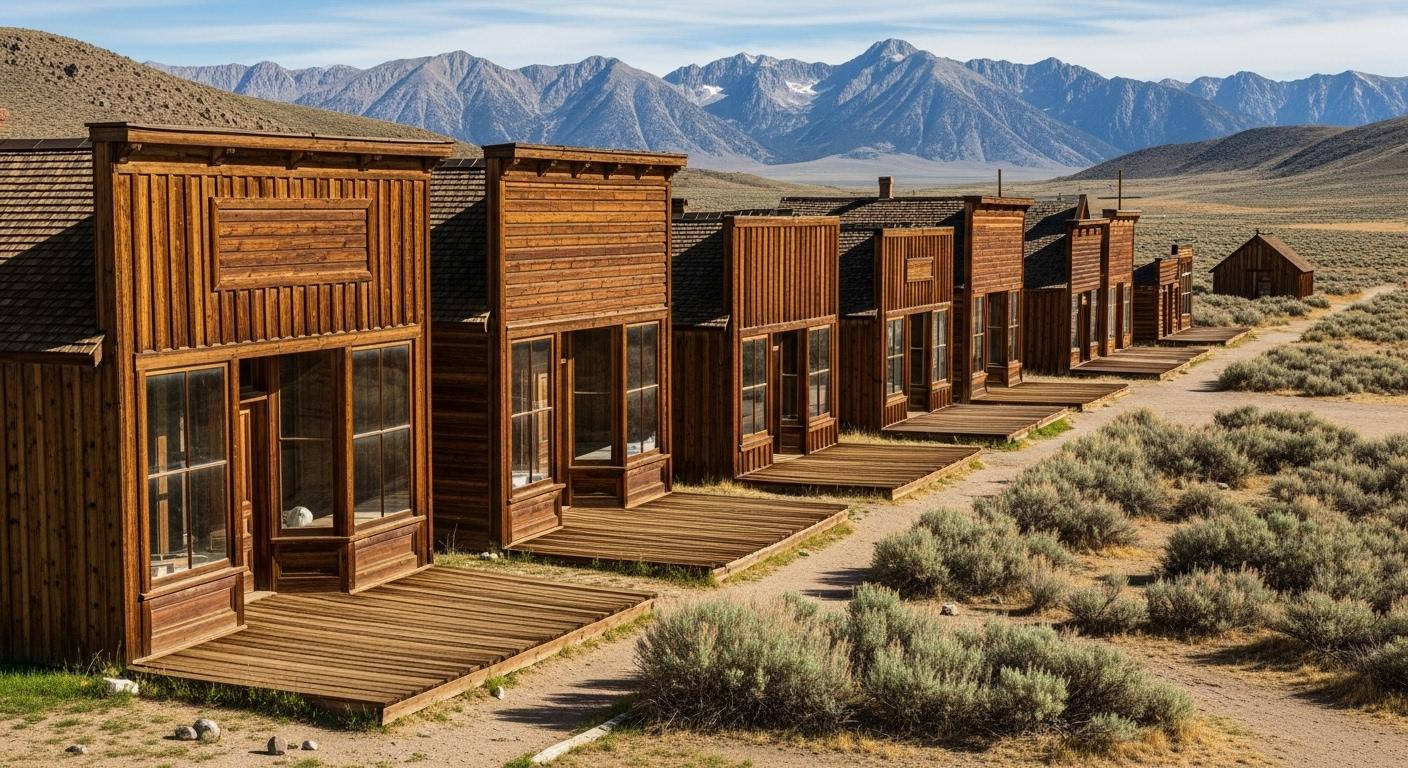Wind howls through weathered boardwalks at 8,375 feet above sea level. Golden-brown wooden buildings stand frozen in time, their windows revealing furnished rooms exactly as residents abandoned them decades ago. You’re 13 miles from Highway 395, where over 4 million Yosemite-bound tourists pass annually without knowing this secret exists. Bodie State Historic Park preserves America’s most authentic ghost town through “arrested decay” – no reconstruction, no theme park elements, just profound Western silence that fewer than 250,000 visitors discover each year.
The ghost town Yosemite tourists never find
Bodie sits 13 miles east of Highway 395 on an unpaved road that filters casual visitors. The final three miles require high-clearance vehicles and patience. At 8,375 feet elevation, this former gold rush boomtown rests 4,375 feet higher than Yosemite Valley.
While Yosemite recorded 4.29 million visitors in 2025, Bodie welcomes just 200,000 annually. The contrast becomes stark when you realize most Yosemite tourists drive right past the Highway 395 turnoff. These 10 ghost towns quietly transform visitors through arts revival and arrested decay, but Bodie stands apart through its uncompromising authenticity.
Seven miles south of Bridgeport, the ghost town emerges from high desert landscape. No gift shops. No reconstructed facades. Just 170 weathered buildings that housed 10,000 miners during the 1880s gold boom.
Where 10,000 miners left everything behind
California State Parks preserves Bodie through “arrested decay” philosophy. Buildings remain exactly as last residents left them in 1962, with goods still stocked on shelves. This approach maintains historical authenticity without theme park reconstruction.
Victorian false-fronts stand frozen in 1880
Weathered wooden storefronts line the main street. Original glass windows reveal period furniture, dishes, and personal belongings inside. The Bodie jail, Methodist church, and schoolhouse with books still on desks create an eerie time capsule effect.
Walking the boardwalks, visitors find small shards of china dishes and square nails scattered in the dust. California State Parks prohibits removing artifacts, preserving the town’s archaeological integrity for future generations.
From boom to ghost in three generations
Waterman S. Body discovered gold here in 1859. The 1875 mine cave-in revealed rich deposits, triggering massive population growth. By 1880, nearly 10,000 residents supported 50 saloons in what locals called “the rowdiest town in the West.”
Gold depletion began the town’s decline in 1910. The last permanent residents departed in 1962 when California designated the site a State Historic Park. Today, only 5% of the original 2,000 structures survive, but their preservation remains unparalleled among Western ghost towns.
Walking through wind and silence
Park entry costs $10 per vehicle in 2025. The self-guided tour covers one mile of main street, allowing visitors to peer through windows into miners’ lives. No crowds block photography opportunities.
The self-guided tour through time
Start at the Miners’ Union Hall, where labor meetings once drew hundreds. The Methodist Church retains original pews and hymnals. These 10 historic inns drop rates 25% when winter crowds disappear, and Bridgeport accommodations similarly offer November rates from $85-$185 per night.
The schoolhouse preserves textbooks from the 1880s. Window glass reveals period clothing hanging in bedrooms. Mining equipment rusts where workers abandoned it. Every building tells stories without modern interpretation panels disrupting the atmosphere.
What May and September reveal
Summer crowds peak in July-August with 650-700 daily visitors. Shoulder seasons of May, June, and September offer near-solitude. Winter closure from November through April protects the site from harsh Sierra Nevada weather.
Golden afternoon light illuminates weathered wood between 4-6 PM. High-desert scents of sagebrush, pine, and dry earth replace Yosemite Valley’s tourist congestion. This October desert park hits 42°F at night with only 12 tents under Bortle 1 skies, and Bodie offers similar high-altitude tranquility.
The eerie beauty locals never advertise
Bodie’s 200,000 annual visitors represent just 4.7% of Yosemite’s crowds. This dramatic difference preserves the contemplative atmosphere that “arrested decay” philosophy protects. Wind through empty buildings creates natural soundscapes impossible to experience at reconstructed sites.
The cemetery on the hillside overlooks the town with weathered headstones marking miners’ graves. Unlike Yosemite’s selfie-line viewpoints, Bodie offers solitary moments for reflection. In 10 quiet U.S. towns, your ears finally stop filtering city noise, and Bodie ranks among California’s most profound silence experiences.
Local tourism boards deliberately avoid aggressive marketing. The unpaved access road and seasonal closures naturally limit visitation to history enthusiasts willing to make the journey.
Your questions about Few tourists know this eerie ghost town near Yosemite answered
When can I visit and what does it cost?
Bodie opens May through September, weather permitting. Entry fees are $8 for adults, $5 for children, with $3 guide maps available. The final three miles require high-clearance vehicles, especially after storms. Most visitors spend 3-4 hours exploring. Bridgeport offers the nearest lodging seven miles north.
Why hasn’t Bodie been restored like other ghost towns?
California State Parks maintains “arrested decay” preservation since 1962. Buildings are stabilized but never reconstructed, preserving authentic atmosphere versus theme-park experiences. This philosophy keeps interiors exactly as last residents left them, with original furnishings and belongings visible through windows.
How does Bodie compare to Calico or other ghost towns?
Unlike extensively reconstructed Calico Ghost Town, Bodie remains unrestored and authentic. Calico offers more tourist amenities but lacks Bodie’s profound historical atmosphere. Bodie rewards visitors seeking genuine Western history over entertainment, with minimal commercialization and maximum authenticity.
At sunset, golden light washes weathered facades while Sierra Nevada winds carry whispers from 1880. The last tourists depart down the unpaved road. You stand alone where 10,000 miners once lived, worked, and dreamed. This is the ghost town that Yosemite’s millions never discover.
